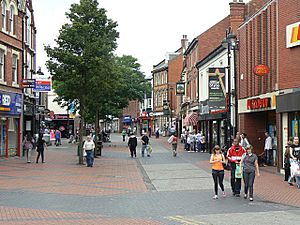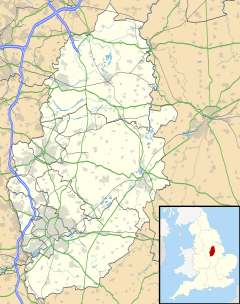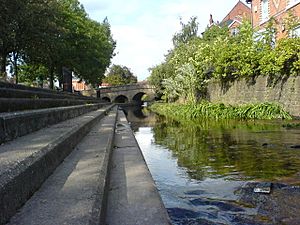Bulwell facts for kids
Quick facts for kids Bulwell |
|
|---|---|
 Main Street, Bulwell |
|
| Population | 29,771 (Bulwell + Bulwell Forest wards. 2011) |
| OS grid reference | SK 53882 45189 |
| Unitary authority | |
| Shire county | |
| Region | |
| Country | England |
| Sovereign state | United Kingdom |
| Post town | Nottingham |
| Postcode district | NG6 |
| Dialling code | 0115 |
| Police | Nottinghamshire |
| Fire | Nottinghamshire |
| Ambulance | East Midlands |
| EU Parliament | East Midlands |
| UK Parliament |
|
Bulwell is a lively market town located in Nottinghamshire, England. It's about 3 miles (5 km) south-west of Hucknall and 4.5 miles (7 km) north-west of the city of Nottingham. In 2011, nearly 30,000 people lived in Bulwell, making up more than 10% of Nottingham city's population.
Contents
Bulwell's Story: A Look Back in Time
Bulwell has a long and interesting history, stretching back over a thousand years!
How Bulwell Began
The first settlements in Bulwell probably started around 800 AD. This was likely when the first bridge was built over the River Leen. The river here was easy to cross, and building a toll bridge made travel safer and quicker. This new road brought many travelers, leading to the growth of Bulwell.
A gatehouse was built for collecting tolls and protecting travelers. This helped the new settlement grow. Travelers needed places to stay and buy things, and Bulwell had plenty of sandstone to build homes. As more people used the road, Bulwell grew bigger and more populated.
Bulwell is even mentioned in the Domesday Book from 1086, where it's called "Buleuuelle" and described as a village. It was already a small trading post, selling goods and services to locals and travelers. This encouraged even more people to move to the area.
By about 1200, Bulwell offered everything needed for animals and their owners. Trade was booming, and many newcomers settled there. Over time, some local business owners felt that new, roaming sellers were taking their trade. To solve this, a law was made around 1320. It said that only businesses with "fixed" buildings could sell goods.
But the law wasn't very clear! Sellers simply put up posts and covers, creating market stalls. These were like the market stalls you see today. Customers liked these stalls, and the market continued to thrive. Bulwell's Market Place is still busy on Tuesdays, Fridays, and Saturdays.
Growing Through the Centuries (1100–1900)
Bulwell's population steadily grew. The town is built on strong magnesium limestone and sandstone, which people started to quarry (dig out) for building. This stone was easy to work with and very durable. Many old houses, schools, and churches in the area are still standing today, built with Bulwell stone. For example, parts of Wollaton Hall, built in the late 1500s, use Bulwell stone.
Coal was also found nearby, often just a few feet underground. This meant that coalmines in Bulwell were among the first in the county to start working commercially, around 1500. Rich men like Sir Francis Willoughby made fortunes from coal. This helped him build the amazing Wollaton Hall. One of the world's first railway lines was built in 1604 near Bulwell to help transport coal from the mines. Horses would pull coal-filled trucks along these rails.
The church on the hill, Bulwell Saint Mary the Virgin and All Souls, was built in 1849–1850. It stands where an even older church from the 1200s once was. You can see it from far away, and its bells ring across the area every weekend.
In 1667, George Strelley built a school for local children. This building is still standing today as a private home. In 1852, a gas pipeline brought street lighting and gas for homes and businesses, which changed life in Bulwell. Clean mains water didn't arrive until 1877, replacing local springs and wells. Before this, river water was often polluted, leading to many illnesses. After 1877, the number of young children dying decreased a lot.
Bulwell Hall's History
Bulwell Hall was a large mansion built in 1770. It was known locally as Pye Wipe Hall. Over the years, it was used as a sanatorium (a place for sick people to recover), a school for boys, and even a camp for Italian prisoners of war during World War II. The hall was eventually taken down in 1958.
A School for Everyone
In 1866, Samuel Thomas Cooper, a generous person who owned Bulwell Hall, paid to build another school for local children. This school could teach up to 518 students! It's still used today as part of St Mary's C of E Primary and Nursery School.
After Cooper passed away, his wife, Annie Cooper, gave money for a new organ for Bulwell St Mary's church. This organ is still used today and has a plaque remembering her husband's gift.
Changes to Bulwell's Borders
Bulwell was its own town until the 1890s, when it became part of the City of Nottingham. The old Town Hall building from the 1800s is now a shop.
Bulwell Today: 1900 to Now
Over the last century, Bulwell has grown a lot with new housing areas like Crabtree Farm and Hempshill Vale. Some of these areas, like Snape Wood and Sellers Wood, were once woodlands. These woods were protected for hundreds of years. However, in the 1960s and 1970s, more homes were needed, so some of the woodland was used for building.
A small part of Snape Wood remains today. It's a local nature reserve, meaning it's a special place for nature. Even though it sometimes needs more care, it's home to many different plants and animals, from wildflowers to hedgehogs and foxes. Sellers Wood is also a nature reserve and is looked after by the Nottinghamshire Wildlife Trust. It's a "Site of Special Scientific Interest" because it's a great example of natural woodland.
Bulwell no longer has working quarries, coalmines, or breweries. Instead, there are now many industrial areas with warehouses, factories, and offices. These areas provide many jobs for people in Bulwell.
Bulwell's Location and Natural Beauty
Bulwell is located near the borders of the Ashfield and Broxtowe districts. The main part of Bulwell sits in a valley along the River Leen.
Bulwell Bogs: A Place for Fun
The "Bulwell Bogs" is a special area next to the River Leen. For over 900 years, it has been a place for children to play, paddle, and even fish.
In 1872, the local landowner tried to take over this land. But the people of Bulwell protested peacefully! Hundreds of them gathered to protect their common land. They marched, had lunch by the river, and then left quietly. They won their fight, and the land was officially set aside for the "pleasure and leisure of the people of Bulwell."
In 2002, there were plans to build a road bridge and transport hub right through the Bogs. But strong local opposition stopped these plans. Instead, in 2003, the Bulwell Bogs were improved with a bigger play-park and a safer paddling pool. It even won a Green Flag Award in 2004 for its regeneration efforts.
Years ago, there was also an outdoor swimming pool called a Lido nearby, which attracted families from all over the city. Sadly, despite local protests, the Lido was taken down in 2006 to build new homes.
Getting Around Bulwell
Bulwell is a major transport hub for north Nottingham. It has three stops on the Nottingham Express Transit tram system: Bulwell, Bulwell Forest, and Moor Bridge. These trams can take you north to Hucknall or south to the city centre.
Right next to the Bulwell tram stop is the train station. From here, trains on the Robin Hood Line go to Nottingham, Mansfield, and Worksop. Bulwell also has a bus station and a taxi rank. The bus station was recently updated in 2023.
Bus Services in Bulwell
Bulwell is well-connected by many bus routes, making it easy to travel to different parts of Nottingham and beyond. Some of the main bus services include:
- CT4N: L14 (Nottingham, City Hospital, Basford, Bulwell)
- Nottingham City Transport: 17, 35, 68/69, 70/71, 79/79A (connecting to various areas like City Hospital, Wollaton, Basford, Rise Park, Arnold)
- Nottinghamshire County Council: 528 (Bestwood, Bulwell, Phoenix Park, Selston)
Learning in Bulwell
Schools in Bulwell have worked hard to improve. In 1999, the area was made an "Education Action Zone" to help solve problems and raise standards. While there's still work to do, things have gotten better.
Marcia Puckey, a headteacher from Hempshill Hall Primary, received an OBE award in 2006 for her amazing work in education.
Bulwell's main new school, The Bulwell Academy, opened in September 2009. It brought together students from two older schools into a modern building.
Life in the Community
Bulwell has many community groups and volunteers who work to make the area better. These include the Bulwell Credit Union, the One Vision Partnership, and active groups like Brownies, Girl Guides, Rainbows, and Cubs. The Bulwell and Basford Rotary Club and Bulwell Community Toy Library are also active.
Bulwell is home to one of the few permanent sites for Irish Traveller families in the country. Local schools have done a lot to help Traveller children feel welcome and included, which has been praised by police and community leaders.
Bulwell has several pubs. One famous pub, The Scots' Grey, used to be known for its boxing club, which trained many champions. Although the pub is now a charity shop, its football team, The Scots' Grey F.C., still plays and has won many local trophies.
Bulwell is also the setting for the online comedy series Charity Shop Sue, which is a funny show about the manager of a fictional charity shop on Bulwell Main Street.
Shopping in Bulwell
Bulwell's town centre has many shops for most needs. While some older stores have closed or moved, new businesses like Costa Coffee and Wetherspoons have opened. Bulwell also has a library, a swimming pool, many churches, and fast food restaurants. You can also find two golf courses, a youth club, a police station, and a hidden Tudor-style arcade.
You'll find several major supermarkets in Bulwell, including Tesco, Aldi, Lidl, and Morrisons. There's also a small shopping area called Springfield Retail Park near the Bulwell Forest tram stop.
Where Does the Name Bulwell Come From?
The name Bulwell is thought to come from a spring called "Bull Well." This spring flows out of the sandstone over a bed of clay. Some people believe the name comes from an old Anglo-Saxon person named Bulla. Others think it describes the bubbling sound of the spring water.
A local legend says that the town was named after a bull hit a sandstone rock, causing water to flow out. A sealed well in a nature reserve is said to be the original spot. Both Bulwell St Mary's School and the Seventh-day Adventist church have pictures of this story carved into stone. Many children in Bulwell have grown up hearing this legend. Recently, a statue of a bull hitting a well was put up in the market place!
Notable People from Bulwell
Many interesting people have connections to Bulwell:
- Albert Ball (1896–1917): A brave pilot in World War I who won the Victoria Cross.
- John Bird (1936-2022): A satirist, actor, and comedian.
- Jason Booth (born 1977) and Nicky Booth (born 1980): Brothers who became champion boxers.
- Stephen Brown (born 1948): A composer, conductor, and teacher.
- Emily Campbell (born 1994): An Olympic weightlifter.
- Steve Chettle (born 1968): A former football player for Nottingham Forest.
- Neil Cossons (born 1939): Former Director of the National Museum of Science and Industry.
- Les Leston (1920–2012): A Grand Prix-winning F1 driver.
- Bertie Mee (1918–2001): A famous football manager for Arsenal.
- Georgie Mee (1900–1978): A footballer and Bertie Mee's older brother.
- Stanley Middleton (1919–2009): A novelist who won the Booker Prize.
- Wilfrid Reid (1884–1973): A professional golfer and golf-course designer.
- Malcolm Starkey (born 1936): An English footballer.
- John White (1855–date of death unknown): A cricketer.
- Charity Shop Sue: A local celebrity and stylist from the web series.








